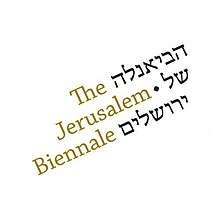Jerusalem Biennale
The Jerusalem Biennale is a Biennale, an art event taking place every second year. The Jerusalem Biennale occurs in different locations around the city center of Jerusalem. It is dedicated to exploring the places in which the contemporary art world and the Jewish world of content meet. It is a stage for professional artists, who create and refer in their work to Jewish thought, spirit, tradition or experience, to exhibit their work in Jerusalem.[1][2][3][4][5] In 2014, the Jerusalem Biennale became a member of the Biennial Foundation, together with more than a 100 Biennales from around the world. [6]

History
The 1st Jerusalem Biennale (2013) was initiated and produced by Ram Ozeri and held in Fall 2013. Participation was by invitation only; participating artists included Andi Arnovitz, Neta Elkayam, Shai Azoulay, Dov Abramson, and Tobi Kahn. The art was showcased in 5 venues located throughout the city. The Biennale hosted works by more than 60 artists, most of them from Israel, and raised the questions of, What is Contemporary Jewish Art? and Does the category even exist? [7][8]
The 2nd Jerusalem Biennale (2015) took place between September 24th and November 5th, 2015, with the Tower of David as the central exhibition space.[9][10] It featured a retrospective of the work of Moshe Zabari and a group exhibition by New York-based artists. The main exhibition was a group show entitled, ‘‘Jerusalem. Passages,’’ with the works of Brazilian artist Pablo Lobato and Israeli artists Ynin Shillo, Sigalit Landau, Dov Abramson, and Motti Mizrachi.[11] A broader range of perspectives was presented, with a significantly larger portion of non-Israeli and well-established artists taking part. The title, Present Work, was tracing the search for a link between Jerusalem and Jewish communities all over the world. [12]
The 3rd Jerusalem Biennale (2017) took place October 1 - November 16, 2017 and introduced a Watershed moment: it was the largest gathering of Contemporary Jewish Art enthusiasts in the history of Jerusalem. The theme of Watershed, as a geological term, examines the water pattern of streams and rivers that split and converge but can also be used as a metaphor for the way people split and converge as individuals and groups. It is used to state a moment of an important twist - an event that changed the course of history. It includes a big Installation by artist Avner Sher. [13]
The Biennale hosted 30 exhibitions and projects from all around the world: NYC, LA and Dallas; London, Paris, Saint Petersburg and Budapest; Sydney, New Delhi, and Singapore; and Jerusalem and Tel Aviv. Over 230 artists participated, with about 100 of those artists from abroad. It is estimated that 30,000 people, through visitors and those exposed to the Biennale as part of their visit to one of the active museums that hosted the exhibitions, helped contribute to the number of visitors doubling relative to Biennale 2015. Biennale 2017 was written up extensively in the news.
A two-day conference, titled “Watershed: Boundaries and Spaces in Contemporary Jewish Art,” was held in cooperation with the Van Leer Jerusalem Research Institute and the Inspire Education Program launched for the first time. Five hundred high school students, from Israel’s geographical and social periphery, visited the Biennale as part of this fully funded program. [14][15] [16] [17]
Upcoming
The 4th Jerusalem Biennale (2019) will take place between October 10th and November 28th, 2019 with the theme, For Heaven's Sake! [18]
Jerusalem Biennale Staff[19]
- Ram Ozeri- Founder and Director
- Dr. Ido Noy- Deputy Director
- Eitam Tubul- Branding and Design
- Lydia Weitzman- Public Relations
- Binyamin Margo- Marketing Director
References
- Harman, Danna (15 September 2013). "At first-ever Jerusalem biennale, Jewish art goes from old-world to avant-garde". Haaretz. Retrieved 24 February 2015.
- "First Time Jerusalem Biennale for Contemporary Jewish Art". Jewish Business News. 18 September 2013. Retrieved 24 February 2015.
- "Jerusalem Biennale Celebrates Contemporary Art". Algemeiner. JNS.org. 9 October 2013. Retrieved 24 February 2015.
- Bauder, Sarah (9 August 2013). "Contemporary Jewish Art Biennale in Jerusalem". YnetNews. Retrieved 24 February 2015.
- Sales, Ben (19 September 2013). "Jerusalem Biennale Festival Aims To Showcase World of Jewish Arts". The Forward. Retrieved 24 February 2015.
- "Biennale Foundation". biennialfoundation.org. Retrieved 24 February 2015.
- Ghert-Zand, Renee (25 September 2013). "Meet the Brain Behind the Jerusalem Biennale". Forward. Retrieved 25 February 2015.
- http://www.jerusalembiennale.org/the-jerusalem-biennale/
- "Jerusalem Biennale 2015 Open Call". Jewish Art Salon. Retrieved 24 February 2015.
- "Open Call: Jerusalem Biennale for Contemporary Jewish Art 2015". biennialfoundation.org. Biennale Foundation. Retrieved 24 February 2015.
- Shea, Christopher (18 September 2015). "Jerusalem Biennale". New York Times. Retrieved 13 October 2015.
- http://www.jerusalembiennale.org/about-the-jerusalem-biennale/
- Alternative Topographies, Jerusalem Biennale site
- http://www.jerusalembiennale.org/biennale2017-1/
- http://www.jerusalembiennale.org/the-jerusalem-biennale/
- Beck, Mordechai (4 November 2017). "'WATERSHED' IN THE CAPITAL". The Jerusalem Post. Retrieved 4 July 2018.
- Phillips, Lior (26 September 2017). "Soak in the awe-inspiring Jerusalem Biennale 2017 with its founder Ram Ozeri". TimeOut Israel. Retrieved 4 July 2018.
- http://www.jerusalembiennale.org/open-call-jb2019/
- "MEET US". The Jerusalem Biennale. Retrieved 2019-07-03.